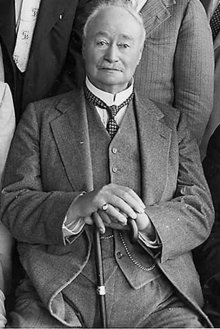Henry Pellatt
Commander of the Royal Victorian Order |
|---|
Pellatt was also a noted supporter of the
Early life and family
Pellatt was born in
Pellatt had three sisters and two brothers, Fred Pellatt (grandfather of Toronto-based freelance writer John Pellatt) and Mill Pellatt (father of Mary Katherine Pellatt).[citation needed] The latter brother was paymaster of the Toronto Electric Light Company, a job obtained for him by Pellatt. His sisters were Mary Kate, Marian Maria and Emily Mountford Pellatt. One of his nieces, Beatrix Hamilton, was married to Canadian economist and humourist Stephen Leacock.
He was educated at Upper Canada College before leaving in 1876 to join his father's stock brokerage company, Pellatt and Osler, as a clerk. In 1882, Pellatt's father and Sir Edmund Boyd Osler parted ways, and Pellatt completed his apprenticeship and became a full member of the stock exchange. In the following year, Pellatt's father set up a partnership with his son under the name Pellatt and Pellatt.
Pellatt married twice, first to Mary Dodgson in Toronto in 1882 and, after Mary's death in 1924, to Catharine Welland Merritt in Toronto in 1927 (which lasted until her death in 1929). With his first wife, he had one son, Reginald Pellatt (1885-1967), who was a Colonel and married with no children.[4]
Military service and honours

Pellatt enlisted as a
In 1910, Pellatt took the entire 600-man regiment (including its horses) to England for military training at his expense, to mark the Regiment's 50th anniversary. The military exercises lasted from August 13 to October 3, 1910.
Pellatt later served as the regiment's Honorary Colonel and was promoted to the rank of Major-General upon his retirement from the regiment. In addition, he was made a Commander of the Royal Victorian Order (CVO) in 1910.
From 1911 to 1923, he was the Knight Principal of the Imperial Society of Knights Bachelor.
Later years

This section needs additional citations for verification. (March 2024) |
Much of Pellatt's fortune was made through investments in the railway and hydro-electric industries in Canada, including the
Prior to building Casa Loma, Pellatt sold his summer retreat in Blantyre / Fallingbrook area of southwest Scarborough to his son Reginald and other parts of the estate to others; Chateau des Quatre Vents at 3025 Queen Street East was built in 1892 by William T. Murray on land acquired from Pellatt former summer estate.[7] E.J. Lennox built another home in front of 3025 and signed as 3027 Queen Street East in 1910. The estate was once on land owned by Peter Patterson and before that Clergy Reserve.[8] Only the groundskeeper home remains and rest of the estate redeveloped into residential homes. His summer estate was destroyed in a fire in the 1920s.[9]
Pellatt later built Bailey House in Mimico, at the bend in Lake Shore near Fleeceline, overlooking the commercial stretch on Lake Shore (the house later became a Legion Hall and was demolished to make way for a roadway). He subsequently moved in with his chauffeur, Thomas Ridgway, and it was in this house that Pellatt died.[10]
After he died on March 8, 1939, thousands of people lined Toronto streets to witness his funeral procession, and he was buried with full military honours.[11] He is interred at Forest Lawn Mausoleum, north of Toronto.
His life has been featured in the film The Pellatt Newsreel, which aired on the
Several biographies have been written about Pellatt. In particular, Carlie Oreskovich's The King of Casa Loma gives a detailed and thorough account. His first wife's great-grandniece, Trelawny Linda Howell, also curates a website dedicated to his memory, CasaLomaTrust.ca.[13]
See also
References
- ^ Sir Henry Pellatt, Dictionary of Canadian Biography, vol. 16.
- ^ Globe, "Mr. Henry Pellatt Dead", 26 July 1909, p. 7.
- ^ Visitation of England and Wales, vol. 9, 1901, ed. Joseph Jackson Howard and Frederick Arthur Crisp, pp. 161-167, Pellatt pedigree
- ^ Colonel Reginald Pellatt, The Queen's Own Rifles of Canada Regimental Museum.
- ^ Major General Sir Henry Pellatt, The Queen's Own Rifles of Canada Regimental Museum.
- ISBN 1-894663-44-6.
- ^ https://www.acotoronto.ca/res_files/TOBuilt-Walking-Tour_Beaches.pdf [bare URL PDF]
- ^ "Blantyre Park".
- ^ https://www.acotoronto.ca/res_files/TOBuilt-Walking-Tour_Beaches.pdf [bare URL PDF]
- ^ Toronto Sketches by Mike Filey, 1995
- ^ Casa Loma – Media Room – Press Releases at www.casaloma.org
- ^ The Pellatt Newsreel. Lush Entertainment.
- ^ Casa Loma Trust website
Further reading
- Flint, David. Sir Henry Pellatt: the King of Casa Loma (book review), Canadian Historical Review, December 1983, pp. 573(2). Gale Document Number:A3033604. Retrieved 25 Sept. 2009.
- Ford, Tom. "Canada's water power", Winnipeg Free Press, Winnipeg, MB, April 28, 2008, pg.13, ISSN 0828-1785, Accession Number: 7BS7BS1111185262. Retrieved 25 Sept. 2009.
- Freeman, Bill and Pietropaolo, Vincenzo. Toronto's Fairy-Tale Castle and Its Owner, Sir Henry Pellatt, James Lorimer, 1999, ISBN 978-1-55028-595-6.
- Globe & Mail. "Fight Will Centre on M'naught Bill: Measure Gives Great Scope To Hydro-Electric Commission: Sir Henry Pellatt Asks That Legislative Inquiry Be Started", The Globe and Mail, Toronto, March 13, 1911, pp. 1,9. Retrieved 25 Sept. 2009.
- Oreskovich, Carlie with foreword by ISBN 978-0-07-548456-1.
- Report on Business Magazine. 75 years ago: Auction of Contents of Henry Pellatt's Casa Loma. Report on Business Magazine, Toronto, July 1999: pg.234. Gale Document Number: A30527643. Retrieved 25 September 2009.
- Time magazine. Canada: Stable Sonics, ASDIC sonar devices secretly manufactured at Casa Lomaduring World War II. Retrieved 25 Sept. 2009.
External links
- The Queen's Own Rifles of Canada Regimental Museum – Sir Henry Pellatt
- Casa Loma website – History
- Casa Loma Trust – website curated by Casa Loma advocate Trelawny Howell, the great-grandniece of Mary, Lady Pellatt
